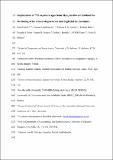Implications of 36Cl exposure ages from Skye, northwest Scotland for the timing of ice stream deglaciation and deglacial ice dynamics
Abstract
Geochronological constraints on the deglaciation of former marine based ice streams provide information on the rates and modes by which marine based ice sheets have responded to external forcing factors such as climate change. This paper presents new 36Cl cosmic ray exposure dating from boulders located on two moraines (Glen Brittle and Loch Scavaig) in southern Skye, northwest Scotland. Ages from the Glen Brittle moraines constrain deglaciation of a major marine terminating ice stream, the Barra-Donegal Ice Stream that drained the former British-Irish Ice Sheet, depending on choice of production method and scaling model this occurred 19.9 ± 1.5–17.6 ± 1.3 ka ago. We compare this timing of deglaciation to existing geochronological data and changes in a variety of potential forcing factors constrained through proxy records and numerical models to determine what deglaciation age is most consistent with existing evidence. Another small section of moraine, the Scavaig moraine, is traced offshore through multibeam swath-bathymetry and interpreted as delimiting a later stillstand/readvance stage following ice stream deglaciation. Additional cosmic ray exposure dating from the onshore portion of this moraine indicate that it was deposited 16.3 ± 1.3–15.2 ± 0.9 ka ago. When calculated using the most up-to-date scaling scheme this time of deposition is, within uncertainty, the same as the timing of a widely identified readvance, the Wester Ross Readvance, observed elsewhere in northwest Scotland. This extends the area over which this readvance has potentially occurred, reinforcing the view that it was climatically forced.
Citation
Small , D , Rinterknecht , V , Austin , W E N , Bates , C R , Benn , D I , Scourse , J D , Bourlès , D L , Hibbert , F D & ASTER Team 2016 , ' Implications of 36 Cl exposure ages from Skye, northwest Scotland for the timing of ice stream deglaciation and deglacial ice dynamics ' , Quaternary Science Reviews , vol. 150 , pp. 130-145 . https://doi.org/10.1016/j.quascirev.2016.08.028
Publication
Quaternary Science Reviews
Status
Peer reviewed
ISSN
0277-3791Type
Journal article
Description
The French national AMS facility ASTER (CEREGE, Aix en Provence) is supported by the INSU/CNRS, the ANR through the "Projets thématiques d’excellence" program for the "Equipements d’excellence" ASTER-CEREGE action, IRD and CEA. The authors would like to thank Shasta Marrero for helpful and informative discussion on the CRONUScalc online calculator. DS was supported by a SAGES studentship and fieldwork by funds from the QRA and BSG.Collections
Items in the St Andrews Research Repository are protected by copyright, with all rights reserved, unless otherwise indicated.

